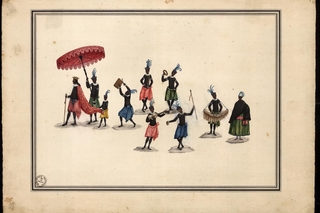Between 1796 and 1798, two Luso-Brazilian Catholic priests Cipriano Pires Sardinha and Vicente Ferreira Pires made a trip to the Dahomey, in the Bight of Benin. Both were appointed ambassadors of Portugal and sent by the Prince Regent Dom João to convert this African kingdom to Catholicism. It also was their mission to produce an account of the journey, describing the parts of the continent that they traveled. Both were mulattos, African descendants, and lived in two cities (the village of Tejuco, in Minas Gerais captaincy, and Salvador da Bahia) where the culture and customs brought by recently-arrived slaves were strongly manifest, including their African music, their dances, their rituals, their drums, their ceremonies and their religions. However, despite the significant presence of traces of African culture in Brazil, and places like the village of Tejuco and the city of Salvador in particular, alterity and intolerance wind up marking the relationship between the author of Viagem de África em o Reino de Dahomé and the Africa of his forefathers. Of course, slave culture underwent permanent transformation, mixed through the cohabitation of people from different regions of Africa in the slave quarters and molded and constrained by the imposition of Portuguese culture and its inbuilt Catholicism. There are numerous accounts of the sharing of African traditions and customs in town-life, even if countless cultural assimilations meant they were no longer a simple reflection of the original practices. For example, every year, a King Congo and Queen Ginga were chosen in Brazilian cities for the Rosary Brotherhood celebrations in a clear throwback to the political organization of the African tribes and kingdoms. These Rosary Brotherhood festivals were examples of how Catholicism was embellished through the African encounter that also had an impact in the religiosity Brazil. Among the slave population this remembering of Africa costumes and political organization was used to empower their Christian conversion and their acceptance both to Catholicism and to slavery. However, despite the significant presence of traces of African culture in Brazil, and in Tejuco or Salvador in particular, alterity and intolerance are what mark the relationship between the author and the Africa of his forefathers: “so we began to observe the extravagant difference there was between our customs and those of the barbarians, and the savage ways of that unhappy race”.[i] This line, like pretty much the rest of the text, reveals a heavily negative vision of the continent, laced with intolerance toward the local habits and customs, always referred to in terms of a lack of civilization and theirs feasts and ceremonies, which are described in details, are indicatives of their barbarianism. The aim of this paper is to compare the descriptions of the Black festivals performed in Tejuco village and Salvador city and the ones witnessed and described by the two priests in Dahomey by the end of the XVIII century.
Junia Furtado is Full Professor of Modern History at the Universidade Federal de Minas Gerais/Brazil. Master degree and Ph.D. in Social History, at Universidade de São Paulo/Brazil. Visiting scholar at Princeton University, year 2000; on History of Cartography at Newberry Library, September/October, 2007; and at Ecole des Hautes Etudes en Sciences Sociales, year 2008.Visiting Professor in the History Department, at Princeton University, spring 2001 and at Instituto de Ciências Sociais/Universidade de Lisboa, from January to Mach 2010. In July 1998, was distinguished with VIII Award Ford Foundation and Carlos Chagas Foundation for Women and Gender Research, with the Project “Chica da Silva: o avesso do mito” (“Chica da Silva: The myth of a Slave Woman”), and in 2004 with Érico Vanucci Mendes Award, Mention of Honor for Works related to race and gender, award by CNPq.Year Nominated to Joaquim Nabuco’s Chair, at Stanford University in 2012. Has books and articles on Slavery in Brazil as Chica da Silva: a Brazilian slave of the Eighteenth Century (Cambridge University Press, 2009), and History of Cartography as The map that invented Brazil (Versal Editors/2013- won Clarival do Prado Valadares Research Prize, 2011 and first place - Best book in Human Science - Jabuti Award 2014 by Brazilian Chamber of Books).
